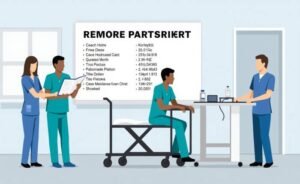How to Stock and Manage Crash Cart Medications Effectively

1. What Are Crash Cart Medications and Why Do They Matter?
Ever wonder what keeps hospitals ready for emergencies? Crash cart medications are drugs on a cart for quick use in life-or-death situations. I’m sharing tips from my nursing days to help you manage them well.
I’ve seen crash carts save lives during heart attacks. They hold drugs like epinephrine to restart hearts or treat severe allergies. Good stocking prevents delays when every second counts.
Key Crash Cart Medications Table
| Medication | Use | Common Dosage |
| Epinephrine | Heart attack, allergic reaction | 1 mg IV every 3-5 min |
| Amiodarone | Heart rhythm issues | 300 mg IV push |
| Atropine | Slow heart rate | 0.5 mg IV every 3-5 min |
| Sodium Bicarbonate | Acid buildup | 1 mEq/kg IV |
Crash carts are vital in emergencies. Stocking them right ensures doctors and nurses can act fast. I’ve been in codes where a well-stocked cart made all the difference.
2. How Do You Pick Crash Cart Medications?
Not sure which drugs go in a crash cart? I’ll share how I chose crash cart medications during my hospital shifts. It’s about meeting emergency needs.
The American Heart Association guides us to pick drugs like epinephrine for heart issues. I once stocked a kids’ cart with child-safe doses for safety. Choose drugs for heart and breathing emergencies.
Hospitals follow ACLS rules for heart drugs. Local laws might add specific crash cart . Smart choices keep carts ready for any crisis.
3. Why Does Storage Matter for Crash Cart Medications?
Think storage affects drug power? I’ve learned crash cart medications need proper care to stay effective. Here’s how to store them right.
Epinephrine fails if it gets too warm. I once found a cart near a heater—huge mistake. Keep crash cart cool and away from light.
Label compartments for quick access. This helped me during a chaotic code blue. Observe manufacturer guidelines to maintain the strength of crash cart drugs.
4. How Often Should You Check Crash Cart Medications?
Wonder how often to check your cart? I check crash cart medications every shift to avoid surprises. Here’s how to stay prepared.
Daily checks catch expired drugs like atropine. I once swapped an old vial just in time for a code. Restock crash cart right after use.
Crash Cart Medication Checklist Table
| Item | Check When | What to Do |
| Epinephrine | Daily | Replace if expired |
| Amiodarone | Daily | Check the correct dose |
| Oxygen Supply | Every shift | Refill if low |
| Defibrillator Pads | Weekly | Test if they work |
Regular checks keep crash cart ready. Missing a check could mean trouble in an emergency. I’ve seen how a quick check saves lives.
5. Who Manages Crash Cart Medications?
Who keeps crash carts ready in your hospital? I’ve worked on teams handling crash cart medications. Let’s talk about who does what.
Nurses like me check carts each shift. Pharmacists ensure drug quality, as I saw during a restocking shift. Emergency teams must know all crash cart .
Training is key to crash cart medications. I’ve taught new nurses cart rules. Clear roles help everyone stay ready for emergencies.
6. What Mistakes Happen with Crash Cart Medications?
Seen a crash cart mix-up? I’ve spotted errors with crash cart medications that can slow care. Here’s what you should avoid.
Expired drugs happen if checks are missed. I once saw a messy cart delay help in a code. Overstocking crash cart wastes money.
Regular training stops errors with crash cart . Always check carts before emergencies. Staying alert keeps things running smoothly.
7. How Do You Train Staff for Crash Cart Medications?

How do you prep staff for emergencies? I’ve run drills on crash cart medications, and they’re a game-changer. Let’s talk about training.
Practice emergencies to use crash cart fast. I taught nurses to grab epinephrine quickly in drills. Go over doses and uses often.
Drills build confidence with crash cart . I’ve seen new staff improve after practice. Use ACLS rules for better training.
8. Why Document Crash Cart Medications?
Why track drugs in a rush? I’ve learned that documenting crash cart medications keeps us ready. Here’s why it’s so important.
Log every drug used or replaced. I track crash cart to avoid running out. Good records help with Joint Commission audits.
Digital tools make logging crash cart easy. They warn about low stock. Records ensure carts are always prepared.
9. How Do Rules Affect Crash Cart Medications?
Curious how rules shape crash carts? I’ve seen regulations guide crash cart medications in hospitals. Let’s look at the standards.
The Joint Commission sets rules for crash cart . I’ve prepped for their audits to ensure compliance. Following the rules keeps patients safe.
Hospitals meet local and national standards. Regular checks follow these rules. Proper crash cart save lives in emergencies.
10. How Does Tech Help Crash Cart Medications?
Can tech improve crash carts? I’ve used tools to track crash cart medications, and they’re a big help. Here’s how tech works.
Automated systems track drug expirations. Barcodes help me pick the right crash cart fast. Digital logs make my reports simple.
Tech cuts errors with crash cart . I’ve seen alerts catch low stock early. Use tools to keep carts ready.
11. How Do You Restock Crash Cart Medications Fast?
What if a cart runs low? I’ve restocked crash cart medications after emergencies. Here’s how to do it quickly.
Replace drugs like amiodarone right away. Our pharmacy keeps crash cart medications ready for restocking. Checklists ensure I miss nothing.
Standard steps speed up restocking crash cart . I report drug use fast. Quick restocking keeps carts ready for action.
12. How Can You Improve Crash Cart Medication Management?
Want better crash carts? I’ve found ways to improve crash cart medications management. Here are my top tips.
Check carts often to find problems. I helped make our hospital’s carts the same for consistency. Train staff on new crash cart .
Team feedback improves crash cart medication systems. Adjust based on real emergencies. Keep working to make carts better.
13. What Are the Costs of Crash Cart Medications?
How much does it cost to keep carts ready? I’ve seen crash cart medication budgets in action. Let’s break it down.
Drugs like epinephrine cost a lot and expire fast. Checks and replacements add up. Training for crash cart medications costs too.
Buying crash cart in bulk saves money. I’ve seen hospitals work with suppliers for deals. Smart plans cut waste and costs.
14. How Do Crash Cart Medications Vary by Facility?
Do all crash carts have the same drugs? I’ve worked in hospitals with different crash cart . Here’s why they vary.
Kids’ hospitals use child-safe doses. Small clinics may have fewer crash cart due to budgets. Big hospitals add complex drugs.
Local rules shape crash cart medications. I’ve set up carts for specific needs. Custom carts work best for emergencies.
Conclusion
Good crash cart medication management saves lives. I’ve seen checks, training, and tech keep carts ready. Stay on top of protocols to ensure crash cart are always set for emergencies.
FAQs
What part does naloxone play in cart drugs?
Naloxone reverses an opioid overdose. It’s a vital crash cart that helps restore breathing and save lives quickly.
Are cart medications checked daily?
Yes, crash cart are checked each day to make sure they’re full, fresh, and ready for any emergency.
Can cart medications expire?
Yes, crash cart can expire. That’s why staff check dates often and replace old drugs to keep the cart safe.




